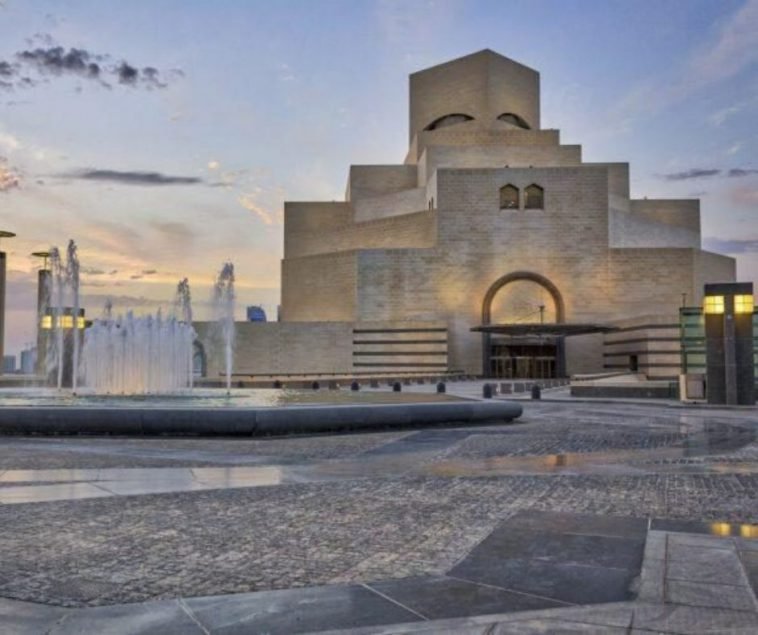The Museum of Islamic Arts, situated in the Persian Gulf, is the largest of its kind and is dedicated to becoming the premier museum of Islamic art worldwide. The museum’s immense size, spanning over 484,000 sq. ft, is a testament to the vision of its architects. The institution is committed to showcasing Islamic art and culture to the world, reflecting the richness, complexity, and diversity of human expression within the Islamic world. This commitment aligns with the vision of Sheik Hamad bin Khalifa Al Thani, His Highness the Emir of Qatar, to transform the State of Qatar into a capital of culture. The Museum of Islamic Art will achieve this goal by building, preserving, and exhibiting a collection that embodies the essence of Islamic art.
The Museum of Islamic Art in Doha is a very impressive building. It was built quickly with lots of resources because it was ordered by the Emir. The building is shaped like a pyramid and is surrounded by turquoise water. This is just one example of many amazing buildings in Doha that combine the traditions of Islam with modern design. The city is growing quickly and becoming a major center in the Middle East.
Modern Architecture
The Museum of Islamic Art in Doha, Qatar is a stunning example of modern architecture. Designed by the renowned Chinese-American architect I.M. Pei, the building features a sleek, cuboid structure with a pyramid-shaped roof that is inspired by traditional Islamic architecture.
The exterior of the museum is clad in cream-colored limestone, which gives it a timeless, elegant look. The façade is punctuated by a series of geometric patterns and recessed windows that allow natural light to flood the interior spaces. The overall effect is one of simplicity, purity, and harmony.
Inside, the museum is just as impressive. The galleries are arranged over five floors and are filled with Islamic art from across the ages, including ceramics, textiles, metalwork, and manuscripts. The spaces are designed to be light-filled and airy, with high ceilings and wide corridors that encourage visitors to explore at their own pace.
One of the most striking features of the museum is its central atrium, which rises up through the entire height of the building. This soaring space is illuminated by a series of skylights that filter natural light into the galleries below. At the base of the atrium is a shallow pool, which reflects the sunlight and adds to the sense of tranquility and serenity within the space.
The interior is also designed to make use of natural light and has a minimalist aesthetic. The building is surrounded by gardens and a park of sand dunes, which provide a scenic backdrop and a place for visitors to relax.
Since its opening in 2008, the Museum of Islamic Art has received widespread acclaim as one of the world’s premier museums. It has been praised for its architecture, as well as its collection of Islamic art, which spans over a thousand years and includes items from across the Islamic world. The museum also features a variety of educational programs and events, making it a hub of cultural activity in the region.
Inside the Museum
The structure of the Museum of Islamic Art combines various traditional Islamic architectural styles, featuring two buildings made of cream-colored limestone – a five-story main building and a two-story Education Wing, connected by a central courtyard.
The Museum of Islamic Art has a unique design that features a circular lighting system hanging from above. The lights draw our attention upwards to the geometric top of the building. Inside, there is a central foyer located far below a designed dome skylight. Two lighting vents at the top resemble the eyes seen on a canopy, adding to the feeling of the place as a natural mosque. The very tall windows provide a clear view of the post-modern skyline of Doha.
The main building of the Museum of Islamic Art
The main building of the Museum of Islamic Art is designed to create a sense of depth as it rises around a domed atrium that is 5-stories high. The walls of a central town conceal the atrium from outside view. The top of the atrium features an Oculus, which captures and reflects the intricate light within the faceted dome.
The two stories of displays that surround the atrium have treasures from the permanent collection. Each chamber is serene and pleasent cool, comfort from the heart and hustle outside; the show rooms highlight specially planned cases and lighting to ensure the brittle antiquities on display.
Museum Collection
The museum collection assortment incorporates original copies, metalwork, ceramics, jewellery, woodwork, materials,coins, texture, and glass gathered since the late 1980s. MIA has an excellent assortment of rare gold and the silver coins which gives a spellbinding understanding into the lives of the Muslim people groups from the seventh century.
- Ground Floor: This floor is dedicated to the exhibition of Islamic art from different regions and periods, including ceramics, metalwork, textiles, and manuscripts. The floor also has a library, a café, a gift shop, and a lecture hall.
- First Floor: The first floor houses galleries displaying the museum’s collection of carpets, woodwork, glass, and rock crystal objects. It also includes a temporary exhibition space, an auditorium, and a conservation lab.
- Second Floor: The second floor is the museum’s main gallery and features a collection of rare and precious objects made of gold, silver, and other metals. This floor also has a study room, a multimedia room, and a children’s library.
MIA has probably most excellent glasswork from enameled glass, in its multicolored grandeur, to gleam and significantly more straightforward cut and shaped pieces at any point delivered in the Islamic world. The collection has more than 800 compositions from Qur’ans from the seventh century to Ottoman works of the nineteenth century. Additionally, the metalwork collection in MIA speaks to the best bits of metal work of the Islamic world from the seventh century to present day times.
Area
The Museum of Islamic Art is located on a man-made island off the south side of Doha’s Corniche, around 60 meters away from the shore. The museum can be reached by a vehicular bridge and two pedestrian bridges that connect it to the coast. It is only a 15-minute drive from Doha International Airport and within walking distance from Souq Waqif. Visitors can easily access the museum by car or private taxi, while the highway 76 bus stations are located just outside the museum gates.
Guest Facilities and Information
The Museum of Islamic Art offers a range of guest facilities and information to enhance visitors’ experience, including:
- Guided Tours: The museum offers free guided tours in English and Arabic. Visitors can also request a private tour.
- Audio Guides: Audio guides are available for rent at the entrance for a nominal fee. The guides are available in several languages, including English, Arabic, French, Spanish, German, Italian, Chinese, and Japanese.
- Gift Shop: The museum has a gift shop that offers a variety of souvenirs, books, and artwork inspired by Islamic art.
- Cafe: The museum has a cafe that serves a selection of hot and cold drinks, light meals, and snacks.
- Prayer Room: The museum has a dedicated prayer room for visitors who wish to pray.
- Wheelchair Accessible: The museum is wheelchair accessible and has facilities for visitors with disabilities, including accessible restrooms and elevators.
- Information Desk: The information desk is located at the entrance and provides visitors with information about the museum, exhibitions, and events.
- Parking: The museum has a dedicated parking lot for visitors. Parking is free of charge.
- Photography: Visitors are allowed to take photographs for personal use. However, flash photography, tripods, and selfie sticks are not allowed.
- Wi-Fi: The museum offers free Wi-Fi access to visitors.
ATM
ATM center is available in the main Atrium
Museum Gift Shop
The Gift Shop which is settled on the ground floor offers a unique cultural and shopping experience. There is a huge swath of only designed products dependent on the MIA magnificent collection from art books to show catalogues, jewellery to home stylistic themes and different blessings and extras, guests can understand and pick their best museum souvenirs.
Museum of Islamic Art Library
The library is on Level 1 in the Education wing. The library has a tremendous collection of books which include Archeology, Islamic Architecture, Calligraphy, Carpets and Kilims, Carvings, Ceramics, Coins, Engravings, Paintings, Metalwork, Silverwork, History, Gardens, Monuments, Religion, Waterworks, Tools and so forth. Teenagers under 18 are permitted inside just when joined by a responsible adult.
Application to study rare books and manuscripts must be affirmed in 24 hours ahead of time. Ensured materials may not be copied or checked. Photos might be allowed for a limited number of pages. Museum staff might have the option to give photos on request.
Open hours
- Sunday 10am to 5pm
- Monday 10am to 5pm
- Wednesday 10am to 5pm
- Thursday 12am to 5pm
At other times by appointment only.
Exploration
Exploration help and private examination rooms are available for visiting researchers inspired by expressions of the human experience of the Islamic world.
MIA Park
The MIA Park is adjacent to the museum where guests restfully stroll in the promenades, take part for no particular reason exercises, eat outside with an awesome display of West Bay or simply gaze at the Doha horizon from the best vantage point in the city. Guests can unwined in the high-sponsored wicker seats while getting a charge out of newly made sandwiches, cakes and servings of mixed greens in the shielded overhangs and harbor breezes of the outdoor cafe.
Teenagers Playground
For teenagers aged 2 to 14, there is a play zone which has a playhouse, sandpit, swings, slides and a bungee trampoline which is safe and all around supervised.
Bungee trampolines Timings:
- Sunday, Monday, Wednesday 10.30am – 8.30pm
- Thursday, Friday, Saturday 12pm – 10pm, Closed Tuesday.
- Cost: 25QR
Bike Hire
Bicycles for adults and teenagers can be hired from the little Gift Shop near to the cafe.
- Accessible 10.30am to 5pm.
- Cost: 25QR every hour
Paddle Boats
Guests can appreciate the paddle boats investigating the calm waters surrounding the museum. Life coats are given and the prepared staff are close by to guarantee the undertakings are as protected as they are enjoyable.
Oar Boats are accessible from 12pm until nightfall.
Cost 25QR per 30 minutes.
MIA Park Bazaar
The Park Bazaar will begin again in October and will be hung on the first Saturday of consistently until April 2014.
Timings
- Daily 10.30am until 11pm
- Closed Tuesday
- Park attractions – Open from 12pm until 10pm
- Park Kiosk open
- Daily 12pm until 10pm
- Closed Tuesday
- Open hours
- Sunday 10:30am – 5:30pm
- Monday 10:30am – 5:30pm
- Tuesday Closed
- Wednesday 10:30am – 5:30 pm
- Thursday 12pm – 8pm
- Friday 2pm – 8pm
- Saturday 12pm – 8pm
Last admission ½ hour before closing
- Tel +974 4422 4444
- Fax +974 4422 4446
Dress Code
Guests are asked to be dressed properly. Entrance might decline to those unacceptably dressed.
Mathaf Shuttle Bus
Free transport among MIA and Mathaf
Wednesday to Sunday 11 am to 5 pm. Transports leave at the top of the hour
Islamic art in the world. Find reviews, special offers and the contact details.
FAQs about the Museum of Islamic Art in Qatar:
What are the opening hours of the Museum of Islamic Art in Qatar?
The museum is open from 9 am to 7 pm on Saturday to Thursday, and 1:30 pm to 7 pm on Fridays.
How much is the admission fee to the Museum of Islamic Art?
Admission to the museum is free for everyone.
Is there a dress code for visiting the Museum of Islamic Art?
Visitors are requested to dress modestly and avoid revealing clothing.
Can visitors take photographs inside the Museum of Islamic Art?
Photography is allowed in some areas of the museum, but not in others. Visitors should check with the staff before taking photographs.
Are there guided tours available at the Museum of Islamic Art?
Yes, guided tours are available in both English and Arabic. Visitors can book a tour at the museum’s reception desk.
Is there a gift shop at the Museum of Islamic Art?
Yes, there is a gift shop that sells a variety of souvenirs, including books, postcards, and traditional handicrafts.
Can visitors bring food and drinks into the Museum of Islamic Art?
No, food and drinks are not allowed inside the museum, but there is a café on the ground floor where visitors can purchase refreshments.
Is there a parking facility available at the Museum of Islamic Art?
Yes, there is a free parking facility available for visitors to the museum.
Please Subscribe Us to get updated with Qatar News, Saudi News, Kuwait News, Health News, UAE News, Iqama, Visa, Jobs, Banking and More.



